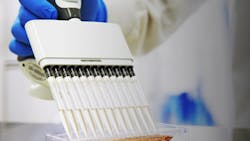AbbVie to Buy Cancer Drugmaker Stemcentrx for $5.8 Billion
AbbVie Inc. agreed to acquire cancer drug developer Stemcentrx Inc. for $5.8 billion, its latest acquisition as it spends billions of dollars on deals to diversify its product pipeline with therapies in oncology.
AbbVie will pay $2 billion in cash and $3.8 billion in stock, and Stemcentrx investors may get an additional $4 billion in cash if certain regulatory and clinical milestones are achieved, the drugmaker said. AbbVie also reported first-quarter earnings that beat analysts’ estimates.
“We have dedicated ourselves to oncology and we view it as our second major growth platform,” CEO Rick Gonzalez said. “Stemcentrx in particular fits well as a major platform play for us in solid tumors.”
AbbVie’s biggest product is the injection Humira, which accounted for 61% of AbbVie revenue in 2015 and will soon face competition in the U.S. from cheaper versions of the complex biotechnology drug, known as biosimilars.
Stemcentrx has five experimental drugs in human trials. Its leading candidate is a treatment for small-cell lung cancer, a deadly subset of the disease with few existing options for treatment. The drug, known as Rova-T, could be on the market by 2018 and eventually have sales of as much as $5 billion a year, according to Gonzalez. The medicine targets a protein called DLL3 that shows up in 80% of small-cell lung cancer patients’ tumors, and not in healthy tissue, according to AbbVie.
Cancer Focus
To reduce the risk posed by dependence on Humira, AbbVie has doubled down on oncology. Last year it acquired Imbruvica, a blood cancer treatment, with its $21 billion purchase of Pharmacyclics. On April 21, it entered a deal with cancer drugmaker CytomX Therapeutics Inc. and simultaneously announced a partnership with Belgian drugmaker Argenx to co-develop an oncology drug.
“We have a very strong and growing position” in blood cancers “and an expanding effort in solid tumors,” Michael Severino, executive vice president of research and development, said by phone. The CytomX and Argenx deals involve earlier-stage programs, while the Stemcentrx acquisition adds a “later-stage program which is derisked,” he said.
First-quarter revenue was $5.96 billion, matching the average estimate of analysts. More results from the statement:
Viekira Pak sales of $414 million, estimate was $514 million. The hepatitis C therapy is competing with Gilead Sciences Inc. and Merck & Co.’s treatments Imbruvica sales of $381 million; average estimate was $367 million Net income of $1.35 billion, or 83 cents a share, up from $1.02 billion, or 63 cents, a year earlier
The company lowered its full-year forecast for profit excluding one-time items to $4.62 to $4.82 a share in light of the Stemcentrx acquisition. In March, AbbVie had forecast $4.82 to $5.02 a share, and analysts have predicted $4.96.
Shares Fall
AbbVie’s shares fell 1.8% to $59.59 at 10:08 a.m. in New York.
“We are cautious to skeptical about the Stemcentrx acquisition and believe that it may be too expensive,” Alex Arfaei, an analyst with BMO Capital Markets, said in a note to clients. “By the time Rova-T reaches the market, AbbVie could be facing much more significant Humira biosimilar headwinds, and Rova-T will likely not be big enough to offset that.”
First-Quarter Results
For the first quarter, AbbVie’s earnings per share excluding one-time items were $1.15, the drugmaker said on April 28, beating the $1.13 average of analysts’ estimates compiled by Bloomberg.
Revenue from Humira was $3.58 billion, beating analysts’ average estimate of $3.52 billion. Mark Schoenebaum, an analyst at Evercore ISI, noted that Humira’s sales beat came from the U.S. market.
AbbVie’s “dependence on Humira may make the company a victim of its own success, like the iPhone for Apple,” wrote Sam Fazeli, an analyst at Bloomberg Intelligence, in a February note to clients. The injection “is at risk of biosimilar copies from 2017, though patents may protect it to 2022.”
About the Author
Bloomberg
Licensed content from Bloomberg, copyright 2016.
